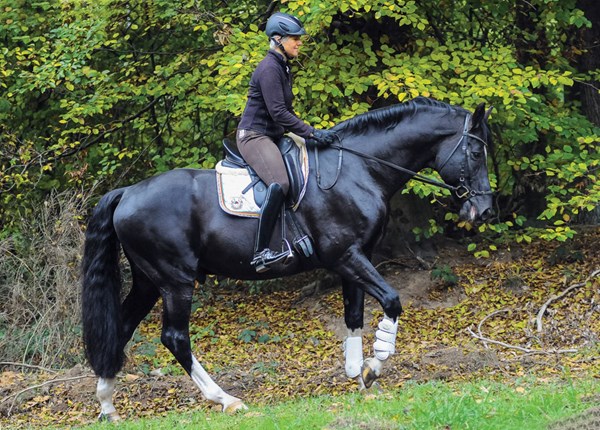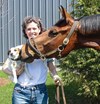Q: My 5-year-old warmblood mare sometimes forges at the trot—not always, just here and there. Is she perhaps overstepping too much? Can this be remedied? If so, what can I do to prevent it? —Name withheld by request
A: This is a fairly common problem, especially with young horses. I’ll go over the mechanics of forging, the most common reasons why horses forge and then give you some ideas that may help remedy the problem.

In a correctly balanced stride the toe of the horse’s front foot should have already lifted off the ground as the toe of the hind foot on the same side is being placed down, so there is no impact of these two feet. When a horse forges, the toe of the front foot is still on the ground as the toe of the hind foot on the same side is being set down, giving time for the two hooves to connect or “forge.”
Some common reasons for this incorrect timing of the gait can include:
• The horse may be having a growth spurt, especially at your mare’s age, which causes her to be slightly higher at the hip than the withers, thus putting her in a downhill balance and causing the front feet to be slow coming off the ground.
• The horse may lack fitness and needs to gain strength to be better able to hold the weight on his hind end, thus freeing the shoulders to come off the ground more easily. You might notice that your horse starts the ride fine, but as she fatigues, she shifts her weight toward her forehand and begins to forge.
• You may need to be more effective at keeping your horse’s balance on the hindquarters. Often, if the rider asks for too fast a tempo, this will cause the horse to run or come off the hind legs too quickly, lose the proper balance and forge.
• If the horse is overdue for shoeing and the hind toes have gotten long, this will throw off the balance of the stride. Even at regular shoeing or trimming intervals there may be an imbalance in the hooves that can contribute to forging.
• A subtle forelimb lameness can make the horse hesitant to pick up his front feet; if the front feet are sore or the shoulders are stiff, the front feet can be slow to come off the ground.
• Poor saddle fit can restrict the motion of the front legs and shoulders, especially a saddle that comes too far forward on the shoulders.
• Conformationally, a horse may have a short back and long legs, thus making it more difficult for the front feet to get out of the way quickly enough to avoid forging.
To help remedy your mare’s forging, first have your veterinarian ensure that there is no underlying soundness issue. Then have your farrier watch your horse move and assess whether he or she can make some changes in the balance of the shoes or trimming of the hooves. Have your saddle checked to ensure that it sits correctly behind your horse’s shoulders and is not too tight.
The most common cause of forging, especially at this age, is that the horse needs to be stronger behind and lighter on the forehand. This allows the front foot to have already come off the ground as the hind foot on the same side lands.
Here are some simple and fun ways to strengthen your horse:
• Get outside and do hill work. Long, straight lines going up a gradual slope, interspersed with some steeper grades, will work wonders for strengthening the haunches and creating a more uphill balance.
• Work over cavalletti. The flexing action of the hind-leg joints as a horse walks, trots and canters over cavalletti is a sure way to build strength.
• Ride clearer and more frequent transitions. Every correct downward transition facilitates the loading action of the hindquarters and the lightness of the forehand. Every upward transition builds pushing power in the haunches.
• Teach your horse how to jump. This is good cross-training building different sets of muscles and it keeps the strengthening work fun for both you and your horse. The horse must lift the forehand and load the haunches to navigate even small jumps.
As with everything, increase all these exercises gradually and listen to your horse. If she seems sore, back off from the exercise a bit, then try again. If you follow these suggestions, your mare’s forging will most likely decrease or stop over time.

Joy Congdon is a USDF Certified Instructor through Fourth Level, an “L” Education Program graduate and has earned her USDF bronze and silver medals. An active competitor through the FEI level, she operates Still Point Dressage and is based in Shelburne, Vermont.











